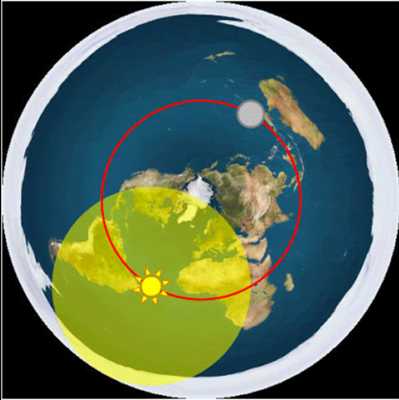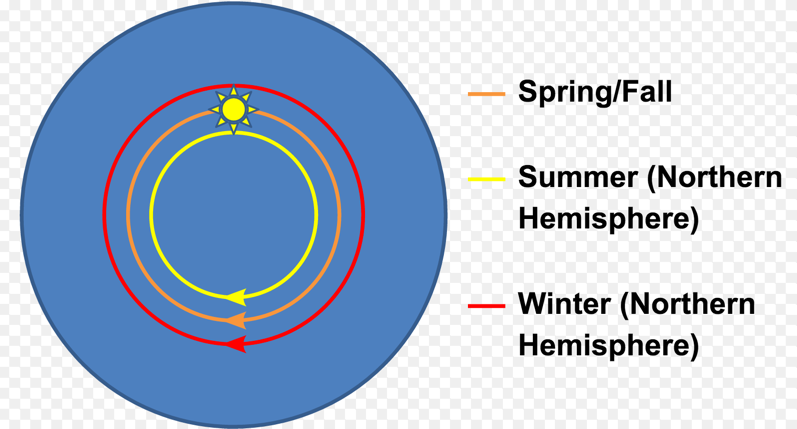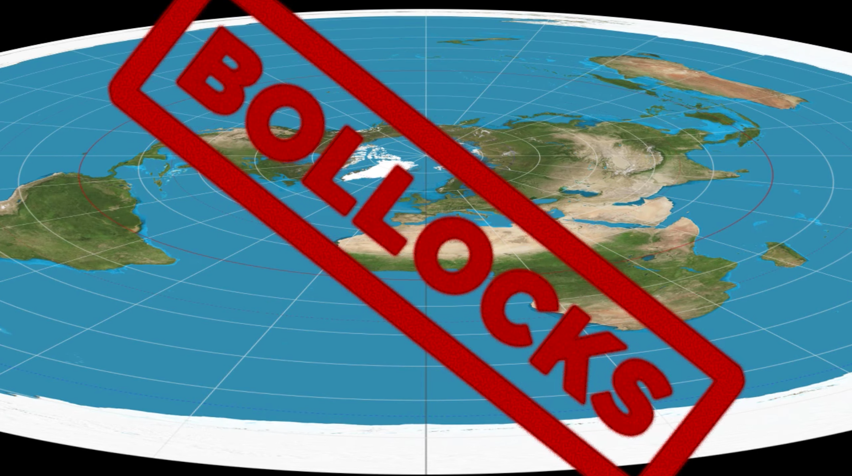Daniel Carter - flat Earth advocate FAIL. He is so wrapped up in the Bible he refuses to accept our physical reality
Hi Daniel,
The world around us can be perceived through several distinct lenses. Our past experiences certainly are a major influence, not to mention our 5 dominant physical senses, our culture (group consciousness) & religion, our stage of mental/emotional development, and so forth.
His claim "I just know that when the trigonometry is actually done the actual distance to the Sun would end up being less than 50,000 miles. You have 15 degrees of difference from 1 time zone to the next and only a little over 1000 miles separating 1 time zone from the next. Mathematically that is proof that the Sun is only thousands of miles away."
Fact check = FAIL
Our analysis:
Yes, each time zone on the Earth is 15o in longitude (as 15o x 24 = 360o). But that same 15o spans a different mile length, depending upon latitude.
Latitude/longitude distance calculator
https://www.nhc.noaa.gov/gccalc.shtml
For example,
15o at the equator corresponds to 900 nautical miles
15o at latitude 40o (north or south) the corresponds to 689 nautical miles
15o at latitude 60o (north or south) the corresponds to 449 nautical miles
15o at latitude 80o (north or south) the corresponds to 156 nautical miles
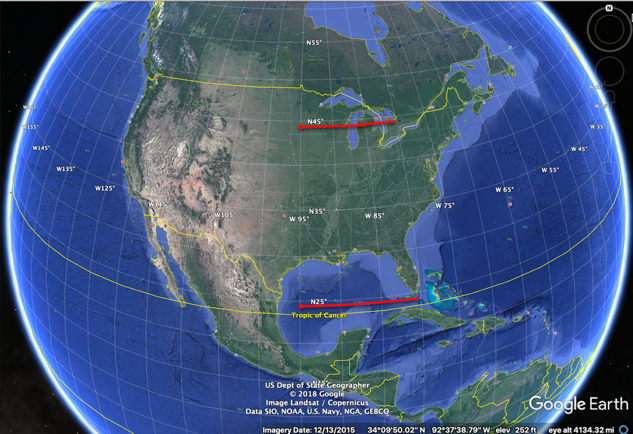
To measure distance, you need to get the parallax angle by direct observation. The parallax angle IS NOT the Earth's 15o time zone.
So for the triangle below, if you determine the parallax angle from two points on the Earth's equator that are 15o apart, then triangle side "a" = 900 nautical miles.
So for the triangle below, if you determine the parallax angle from two points on the Earth's latitude of 60o, that are 15o in longitude apart, then triangle side "a" = 449 nautical miles. etc.
Based on the two locations that you choose, all you have is the side "a" distance. Nothing else. To get the distance to any object in space, angular parallax needs to be measure from BOTH locations. THAT ANGLE IS NOT 15o
Do you understand this or not?
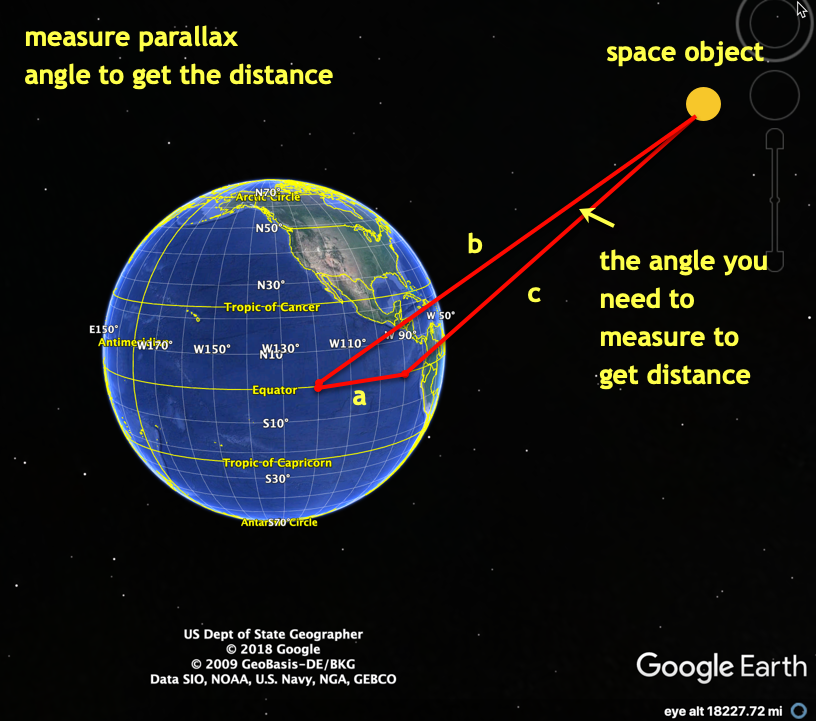
Contrary to flat Earth denial, the distance to the Sun is well known (93-million miles)
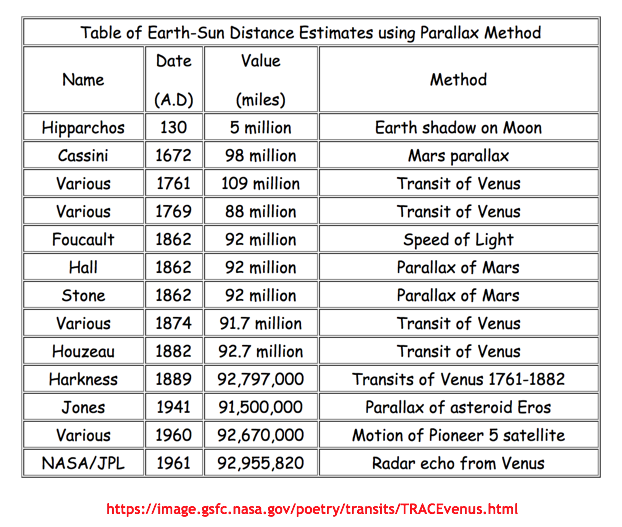
-
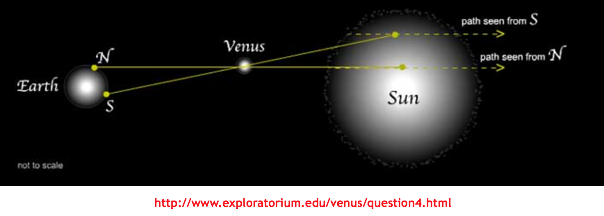
Over the millennia different techniques have been used to measure the Sun’s distance from the Earth (see chart above). In modern times that distance has been measured to greater and greater accuracy.
But the tale of the 1761 transit of Venus attempt, which started international scientific cooperation and was conducted during wartime, proved to be a heroic successful undertaking.
Here is the story as told by Sky & Telescope Magazine…
Transits of Venus in History: 1761
https://www.skyandtelescope.com/astronomy-news/observing-news/transits-of-venus-in-history-1761/
With the scale of the solar system at stake, and knowledge of an upcoming transit in 1761, astronomers did something they wouldn't normally have done: they actually tried to cooperate across borders. European powers such as Great Britain and France held colonies and trading posts all over the world, so astronomers were motivated to organize the first international scientific project in human history: sending expeditions of highly competent astronomers and support personnel to various locations around the world, equipped with telescopes, pendulum clocks, and other quality instrumentation. Astronomers could combine measurements from far-flung locations to determine the a.u.
But then a nasty little war happened to intervene. Known as the Seven Years' War (or the French and Indian War in the U.S.), Britain and her allies engaged in a bitter struggle with France and her allies for worldwide maritime supremacy. The first global war, it raged from 1756 to 1763. The British eventually gained the upper hand (taking possession of Canada in the process), but astronomers were among the losers. With warships roaming the oceans and bombarding coastal cities, transit expeditions became more expensive, complicated, and hazardous,
A case in point was a British expedition to Sumatra (an island in modern-day Indonesia) funded by the Royal Society and led by astronomer Charles Mason and surveyor Jeremiah Dixon (the two who would later become famous for marking the boundary between Pennsylvania and Maryland). Just 24 hours after departing from Portsmouth, their frigate, the HMS Seahorse, was attacked and seriously damaged in a battle with the more heavily armed French frigate L'Grand. Mason and Dixon hunkered down in the bowels of their ship and listened to their fellow crewmen scream in agony as they were cut down by artillery and musket fire. Overall, 11 British sailors died and 37 were wounded. After an hour of fierce combat, the Seahorse was forced to return to port (but not before giving chase to the fleeing L'Grand).
As any sane person can imagine, Mason and Dixon lacked enthusiasm for another trip. But threatened with prosecution and severe punishment if they didn't try again, Mason and Dixon set sail once their ship was repaired. This time they avoided contact with French ships. But as they were sailing southward in the Atlantic, they realized they had no chance of reaching Sumatra in time for the transit. So they showed up unannounced at the Dutch colony of Cape Town in modern-day South Africa. The Dutch were neutral in the war, and the colonial administrators were sympathetic to the scientific nature of the expedition. The team was permitted to disembark and set up their equipment. Mason and Dixon caught the second half of the transit, the only successful observation of the 1761 transit from the Southern Hemisphere.
etc.
(Go to the article to finish reading it)
- - -
Video comments...
JonahTheScientist said,
For your Sun trigonometry calculation, what is the right triangle ANGLE (give me in degrees) that you got, and length of at least two side, so that I can duplicate your findings. OK? kind regards,
Daniel Carter said,
If you know the distance between just two points, and can get angles from each point to a third point, you can figure the distance to the third point triangles usually have 180 degrees. Each time zone around the world is barely over 1000 miles from the next time zone. If a person in one time zone looks at the sun at the exact same time as a person in a nearby time zone they will both see the sun at different angles. There may need to be a bit of a mathematical adjustment for the angles measured from a round Earth. But even after any adjustment the Sun can only be several thousand miles away, not millions.
JonahTheScientist said,
+Daniel Carter, yes in that Euclidian Geometry and Trigonometry can be used to calculate distances. OK, but so what? Show you'r calcs and the distance to the Sun that you got. Let's see your math. What distance did YOU get? What angle did you measure, and at what time, and what is the latitude & longitude of your two observation points? NO DATA MEANS YOU HAVE NOTHING IN HAND. But in 1889 a group of astronomers around the world used this same trigonometry technique, watching the transit of the planet Venus across the face of the Sun, and came up with 92,797,000 miles to the Sun. That is from actual real life observations. Go to FlatEarthLunacy dot come and search for article... "Contrary to flat Earth denial, the distance to the Sun is well known (93-million miles)" There you will see the results of many different types of ACTUAL MEASUREMENTS made to get the distance to the Sun. kind regards,
Daniel Carter said,
@Jonah TheScientist Nice try. As much as people want to wish and pray, and hope they could get away from God. God brings the focus back to Him every time. You have 15 degrees of difference from 1 time zone to the next and only a little over 1000 miles separating 1 time zone from the next. Mathematically that is proof that the Sun is only thousands of miles away.
JonahTheScientist said,
+ Hi Daniel, unfortunately you are picturing this situation incorrectly. I drew some stuff for you to look at. Go to FlatEarthLunacy dot com, and select article "for Daniel Carter" at the top right. Read the article and tell me what you think. kind regards,
Daniel Carter said,
@Jonah TheScientist I agree for the most part with everything said. I do not know what the actual angles would be, I just know that when the trigonometry is actually done the actual distance to the Sun would end up being less than 50,000 miles. Thank you for your time.
JonahTheScientist said,
@Daniel Carter Hi Daniel, I'm speaking to you now with compassion and respect. The 50,000 mile number for the distance to the Sun is wrong. Period. List here the URL or article / video name that concludes 50,000 so that we can examine it together. This is not a challenge to God or your faith. What's is wrong in saying that God created the heavens and the Earth, and the Sun at 93 millions miles to protect us from its blazing fiery heat? And God also created the ozone layer in the Earth's upper atmosphere, to protect us from the Sun's ultraviolet radiation. Without that ozone layer no living creature could survive on the Earth's surface. There would be only plants. No animals of any kind on the Earth. Think about that please. kind regards,

Daniel Carter said,
@Jonah TheScientist Thank you very much for your time. Please watch my video “A Scientific Scam” https://www.youtube.com/watch?v=ESBwWHJ0Bo4 This video covers a lot of ground, and I would have disagreed with most of it just a few years ago. I would really like any scientific critique you may have for this video.
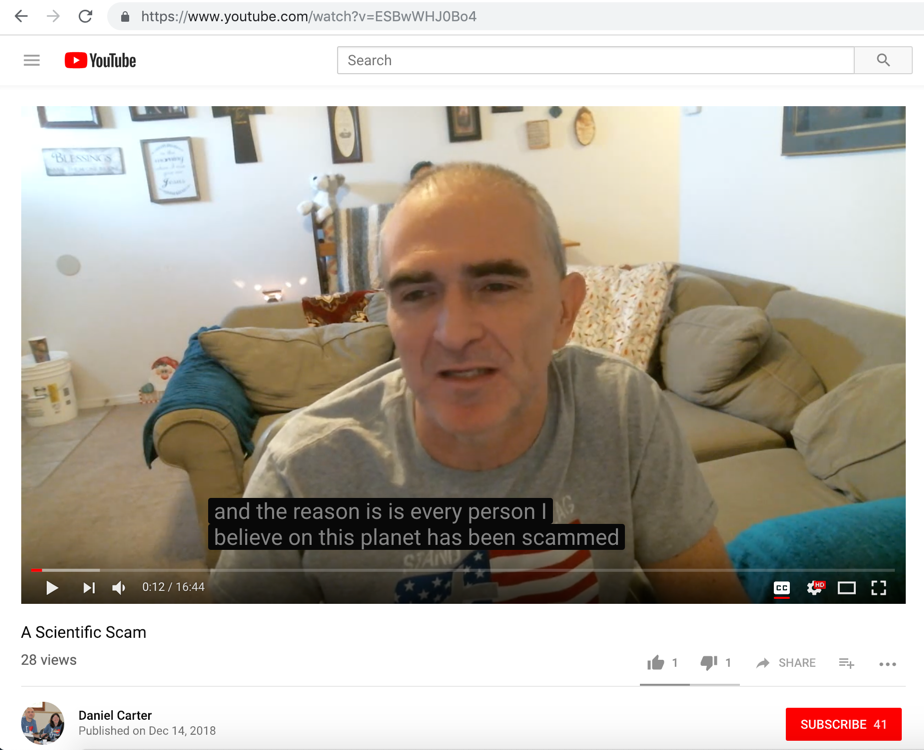
His video - A Scientific Scam
Daniel Carter said,
Every person I believe on this planet has been scammed science that’s falsely so called, and if you have a Bible you could turn to Timothy 6:20. Timothy has warned there not to be entangles in science that’s falsely so called. Science itself couldn’t even exist without an intelligent god that created our intelligence and things like that and made us able to do science…
-
Update: June 14, 2020
New Horizons is so Far From Earth That the Positions of the Stars Look a Little Different From its Perspective, by Matt Willimans at universetoday.com
https://www.universetoday.com/145888/new-horizons-is-so-far-from-earth-that-the-positions-of-the-stars-look-a-little-different-from-its-perspective/
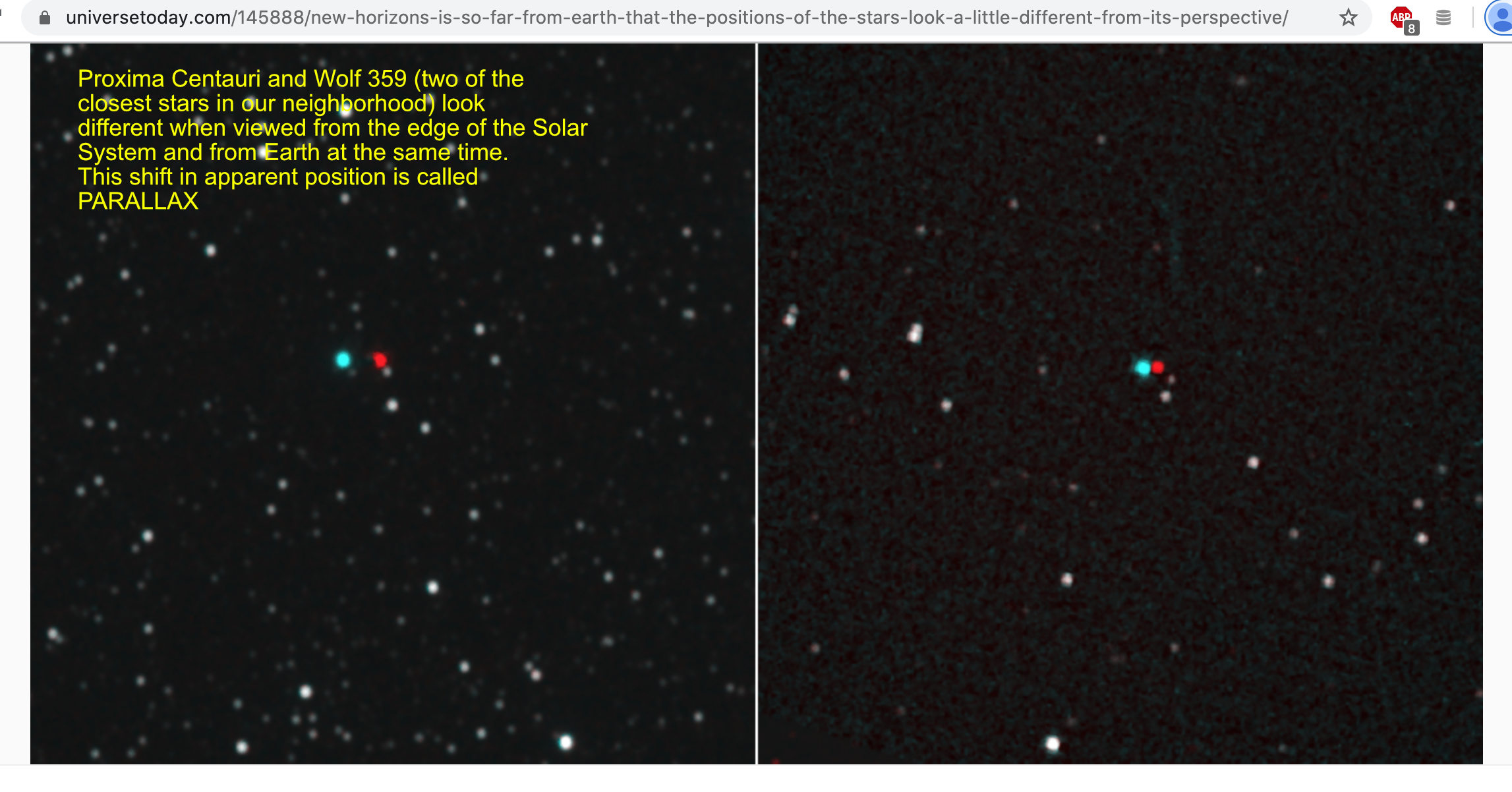
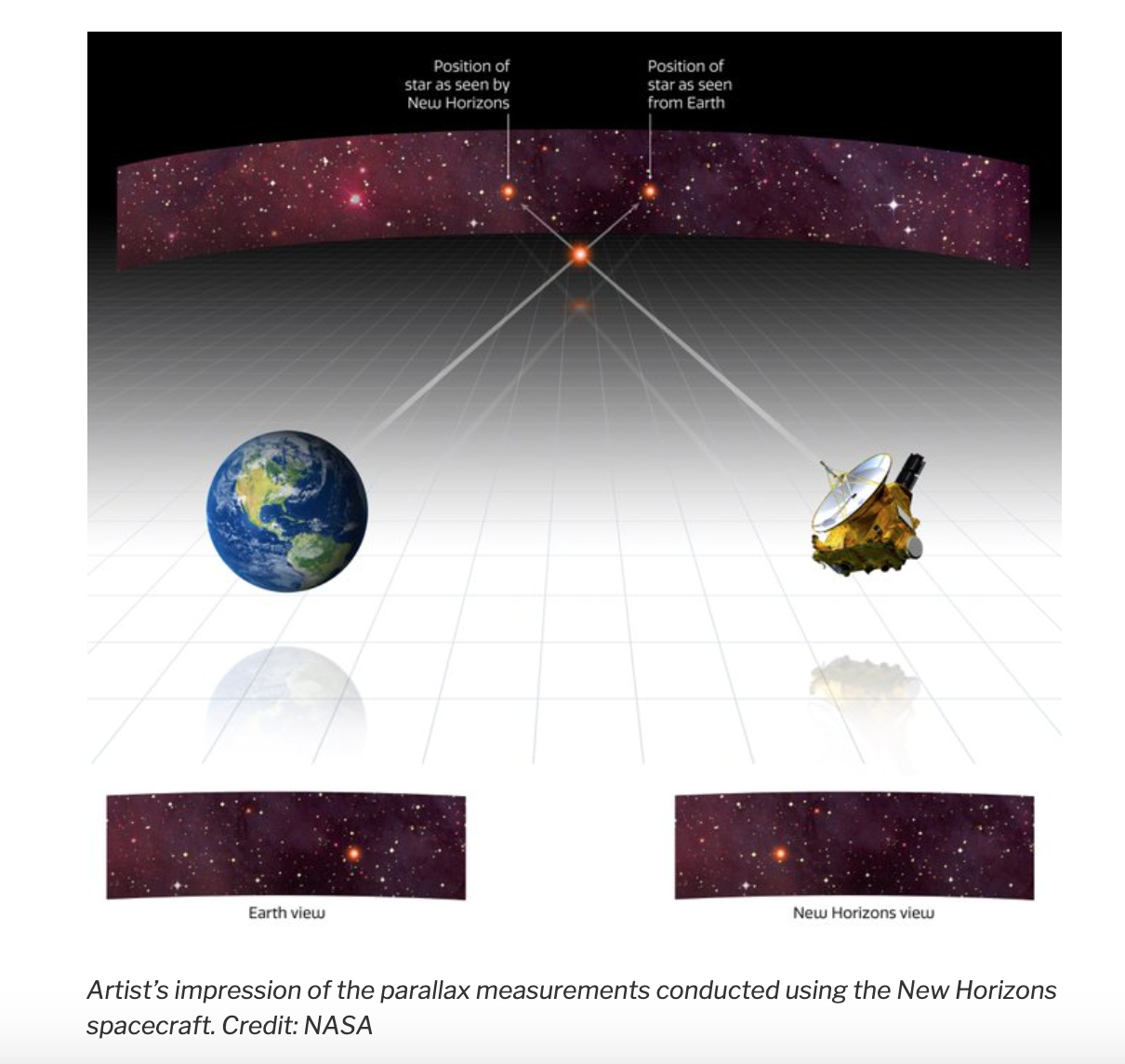
Excerpt:
For example, we here on Earth are used to thinking that the positions of the stars are “fixed”. In a sense, they are, since their positions and motions are relatively uniform when seen from our perspective. But a recent experiment conducted by the New Horizons team shows how familiar stars like Proxima Centauri and Wolf 359 (two of the closest stars in our neighbors) look different when viewed from the edge of the Solar System.
Located in the constellation Leo, Wolf 359 is an M-type (red dwarf) star that is roughly 7.9 light-years from Earth. It can be found close to the same path the Sun follows through the sky (the ecliptic), but can only be seen with a telescope. And if you’re a Trekkie, you might recognize the name since it was where that major battle with the Borg took place (don’t act like you don’t know!)...
...
This technique involves measuring the relative positions of stars from two different locations to detect any possible shift with respect to more distant objects. For almost two centuries, astronomers have used this technique to measure the distance to nearby stars. Traditionally, astronomers have relied on Earth’s own orbital motion to determine these distances.
Since Earth’s orbit is about 300 million km (186 million mi) in diameter, its vantage point changes considerably in the course of a year. But with greater distances and Earth’s orbit as a “baseline”, astronomers can conduct greater parallax measurements. Given its current distance from Earth, the New Horizons mission team and NASA have decided to do this very thing, and invited the public to participate...
(Please go to the URL listed above and read the entire article)
- - -
Published on – January 4, 2019
Discussion at - https://www.youtube.com/channel/UC7ipUKERU0tzYFxALJBli4A/discussion
Our home page all articles - http://flatearthlunacy.com
kind regards, JonahTheScientist
- - - - - - - - - -

- - - - - - - - - -



